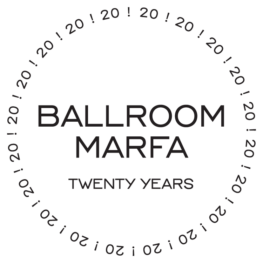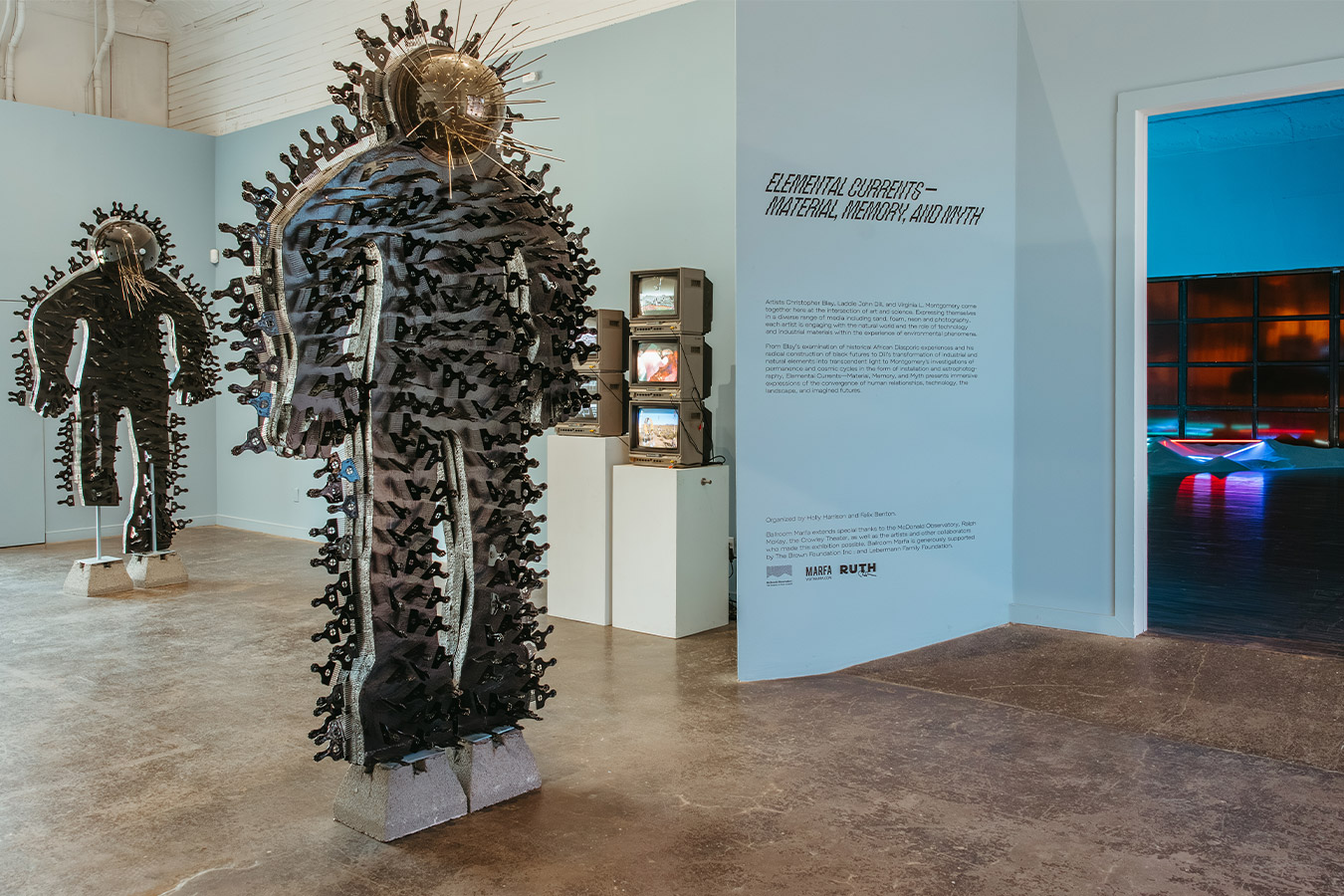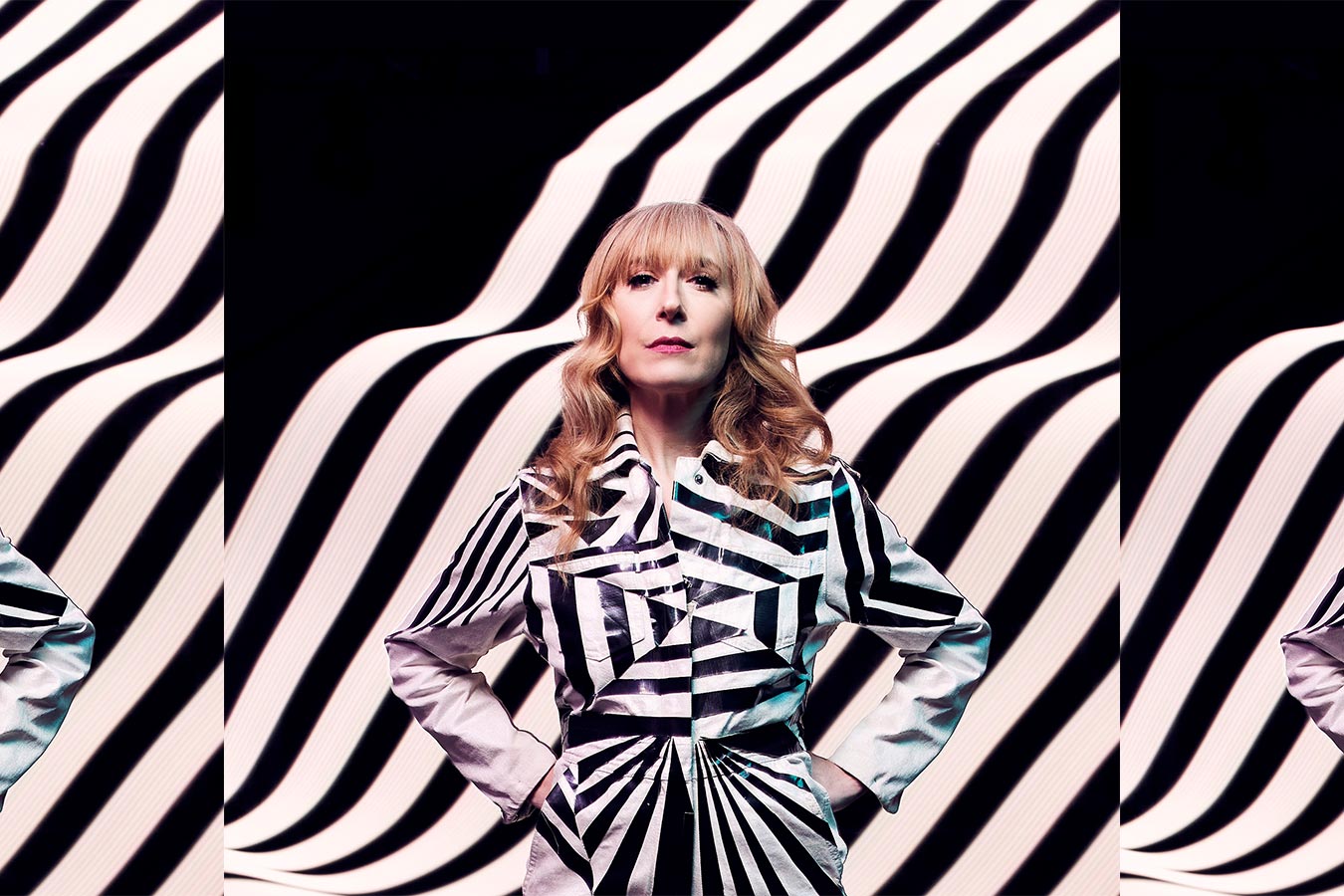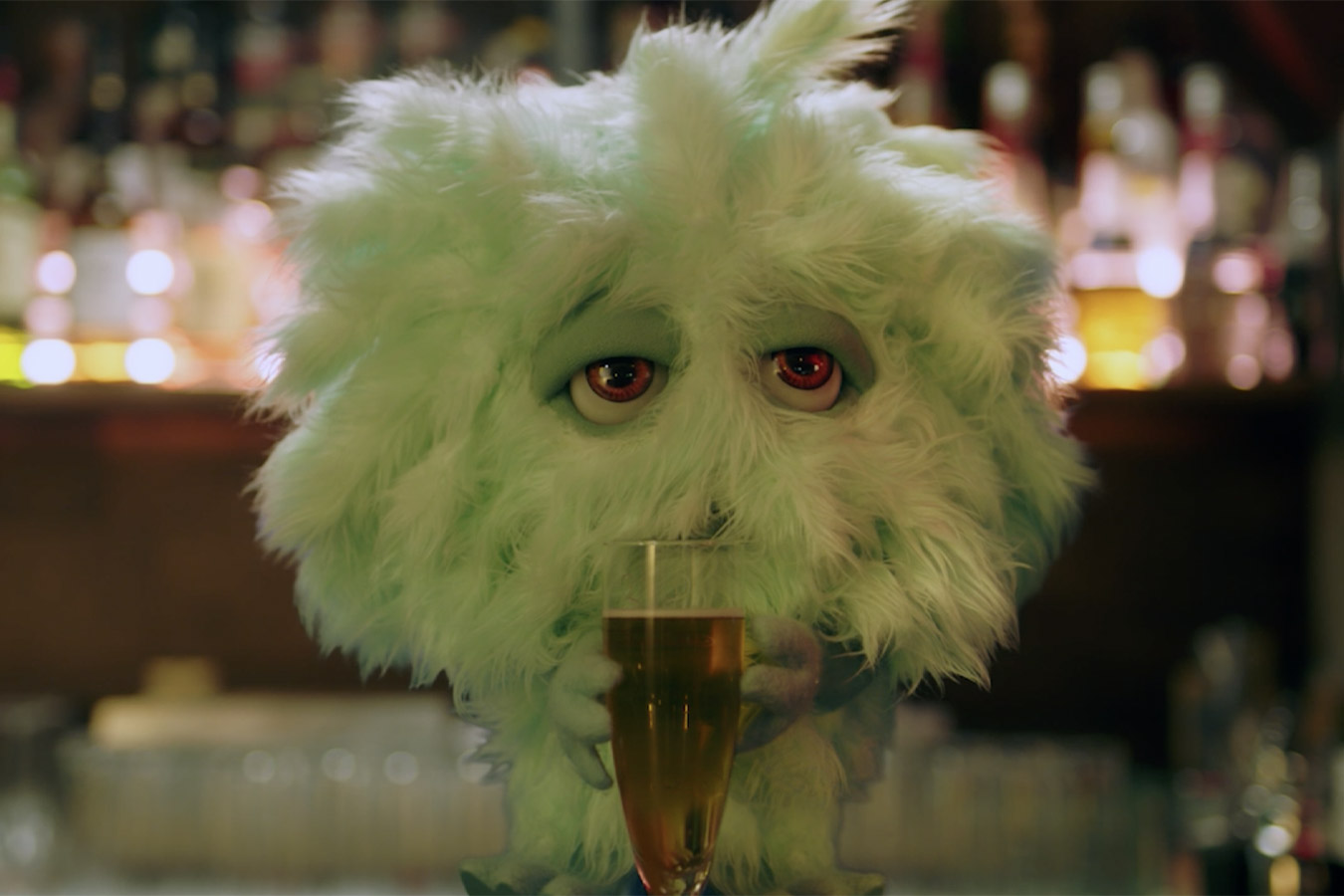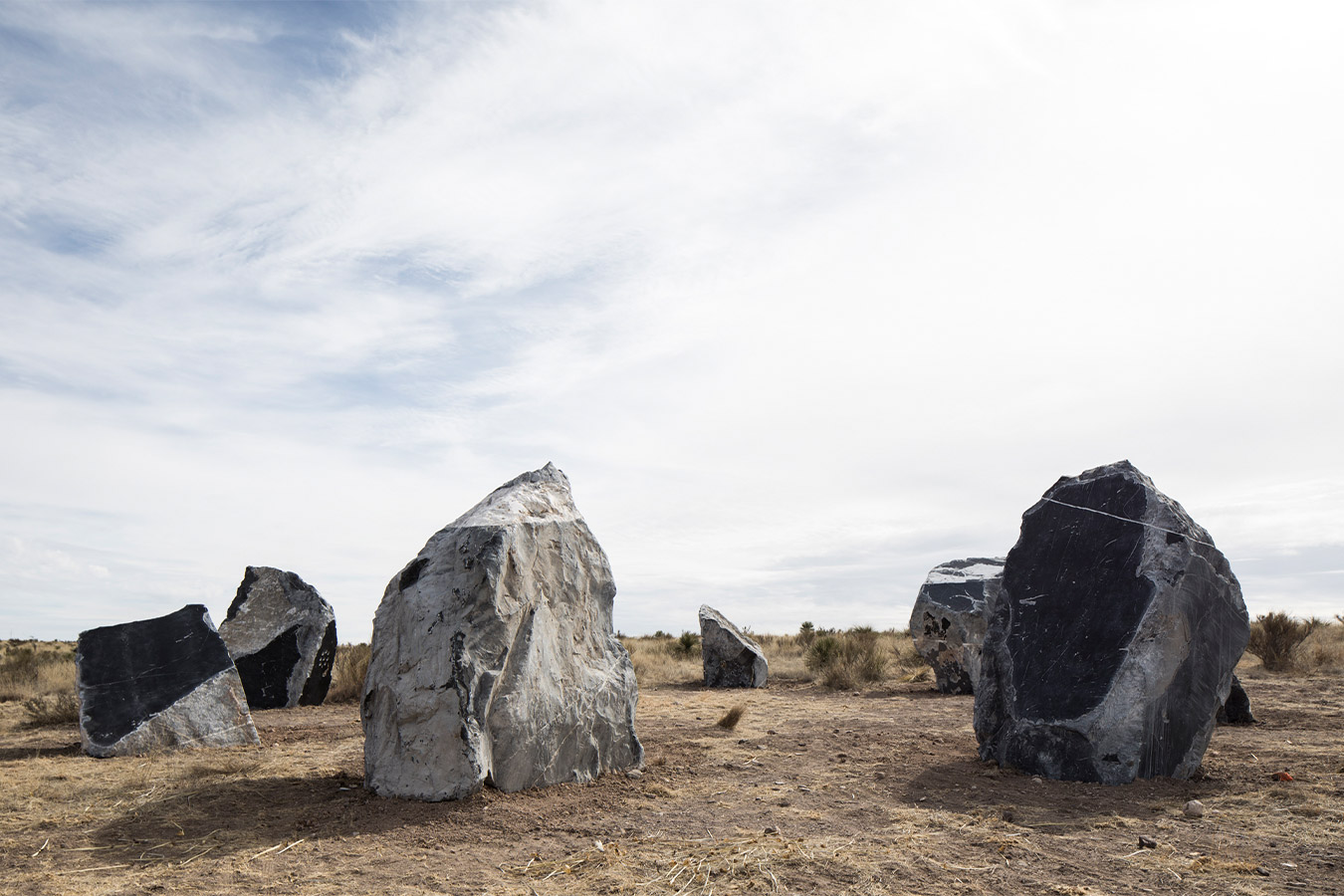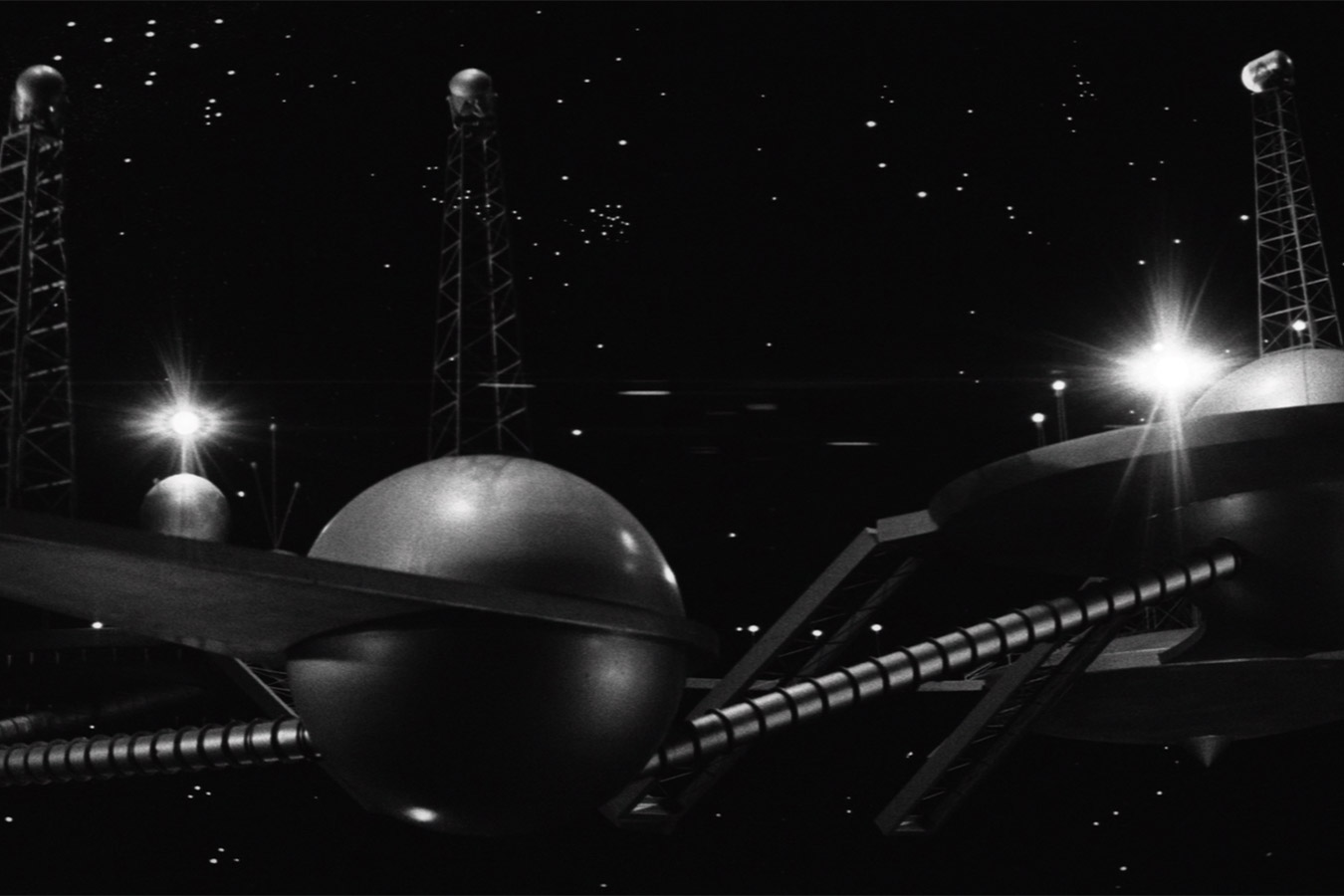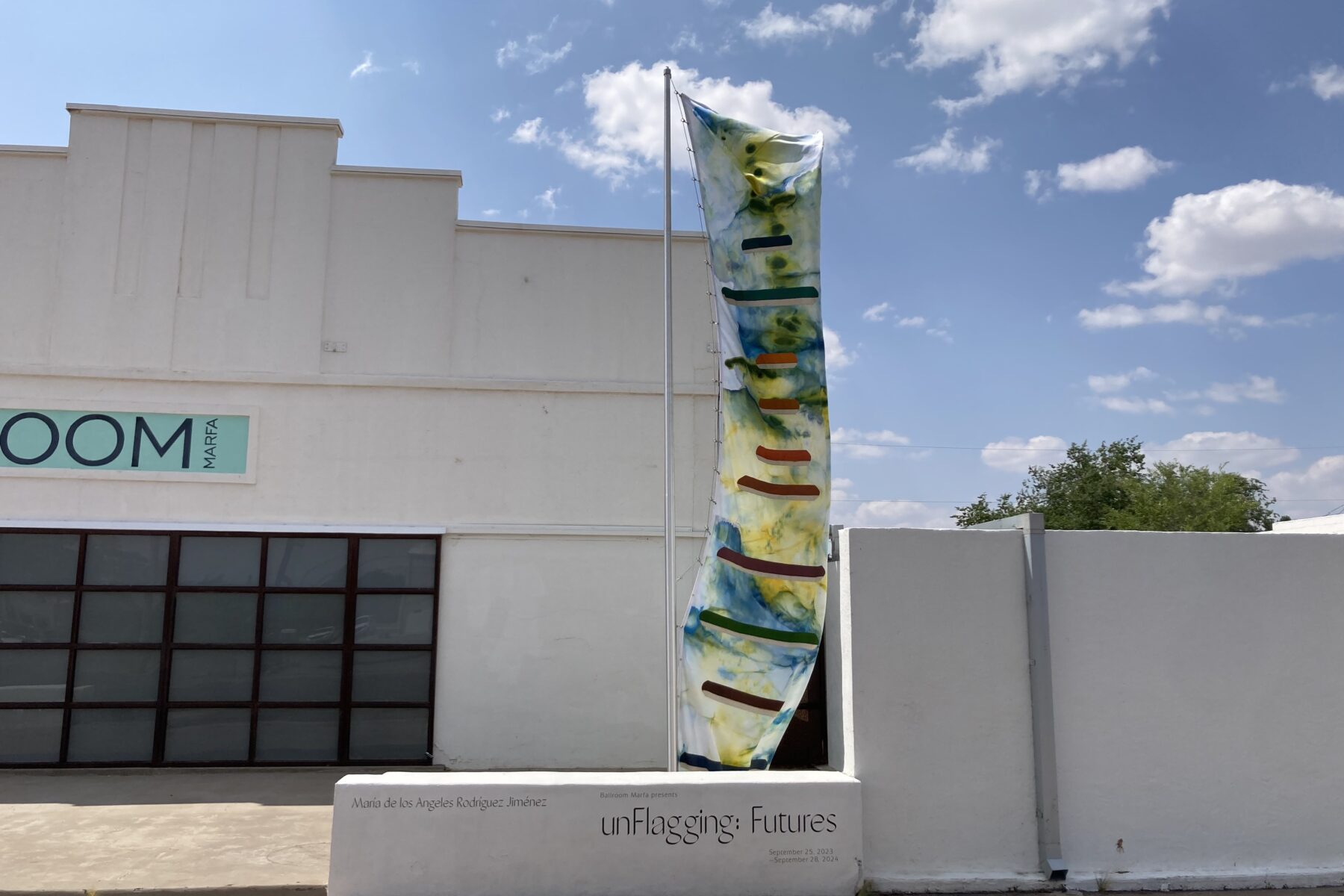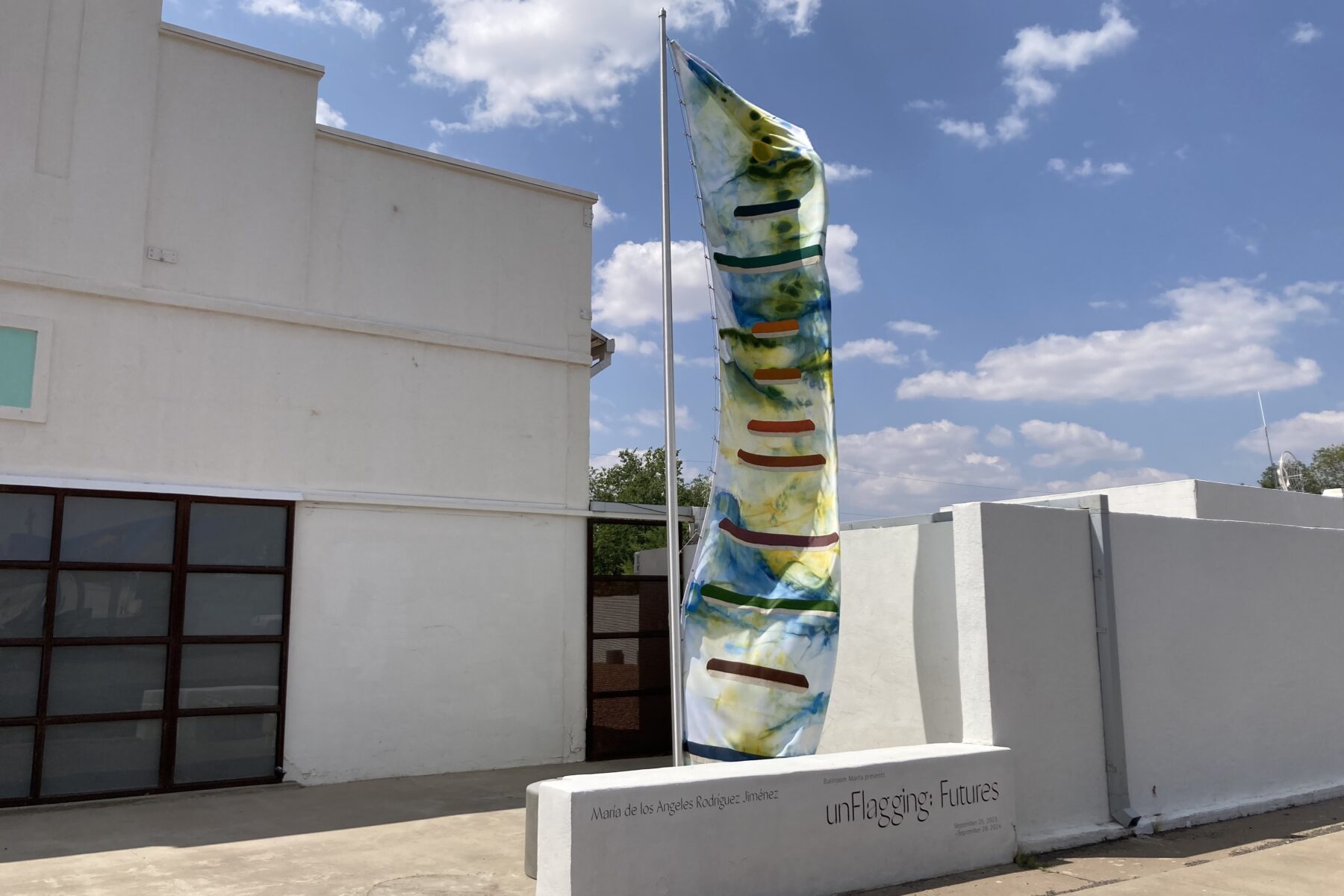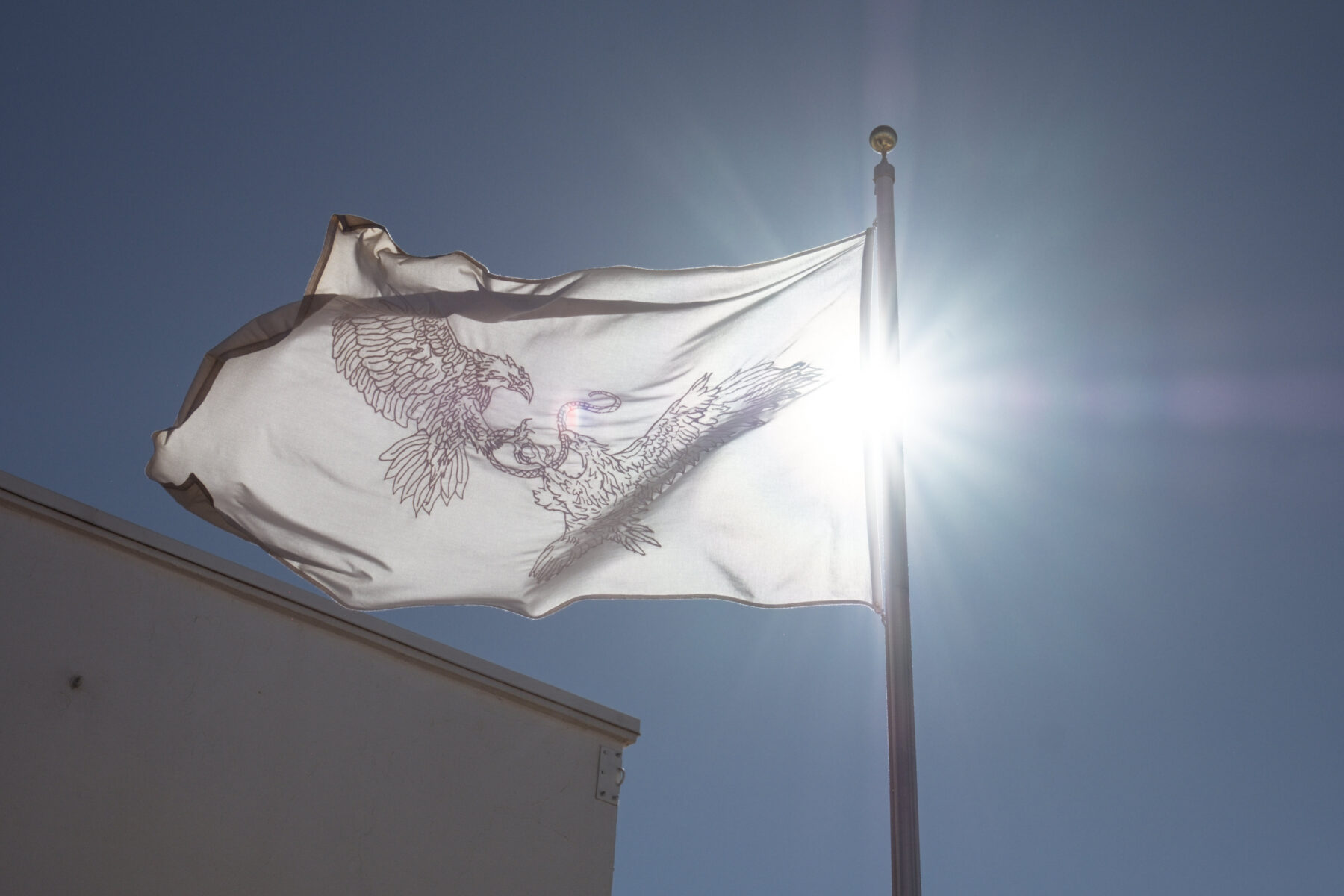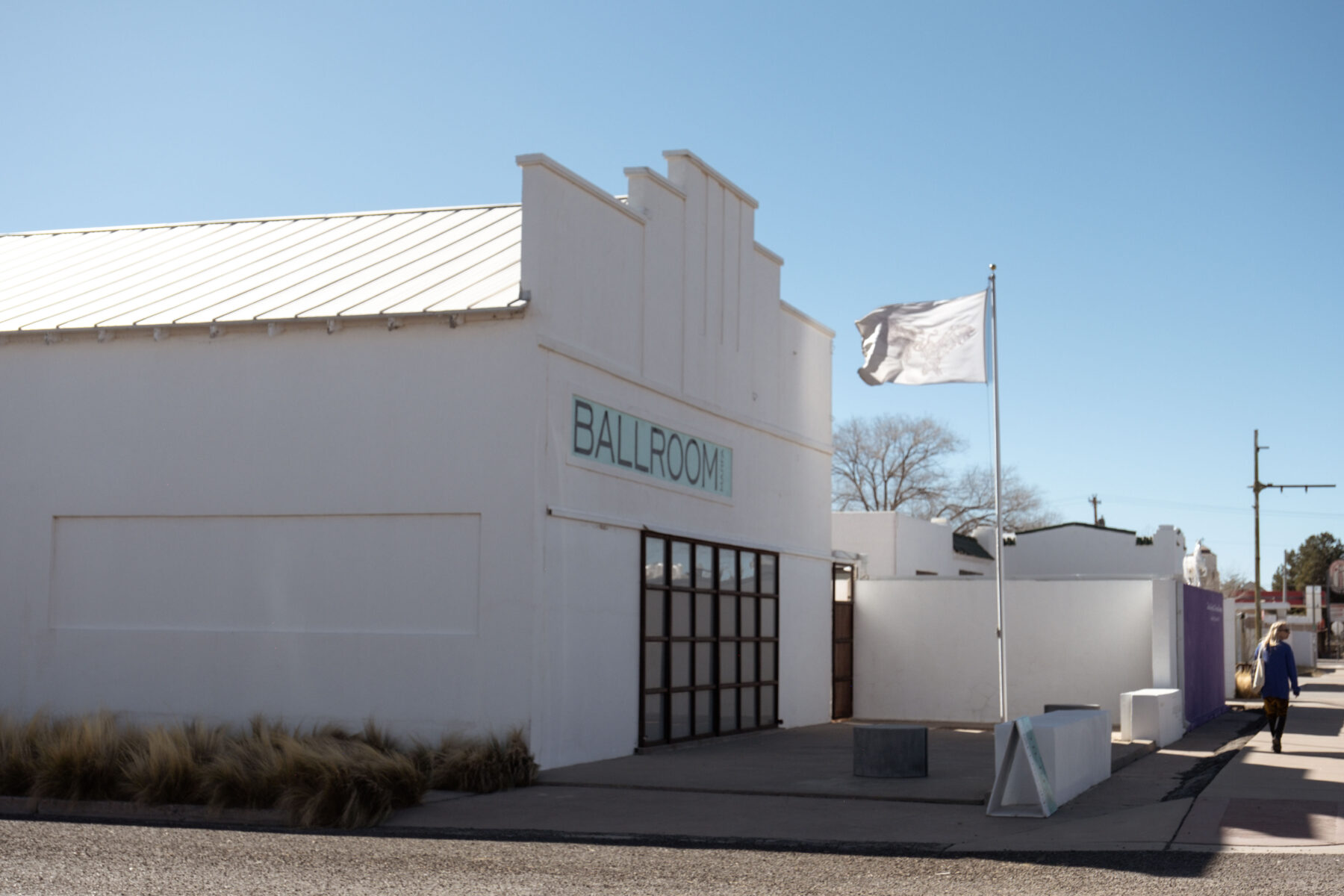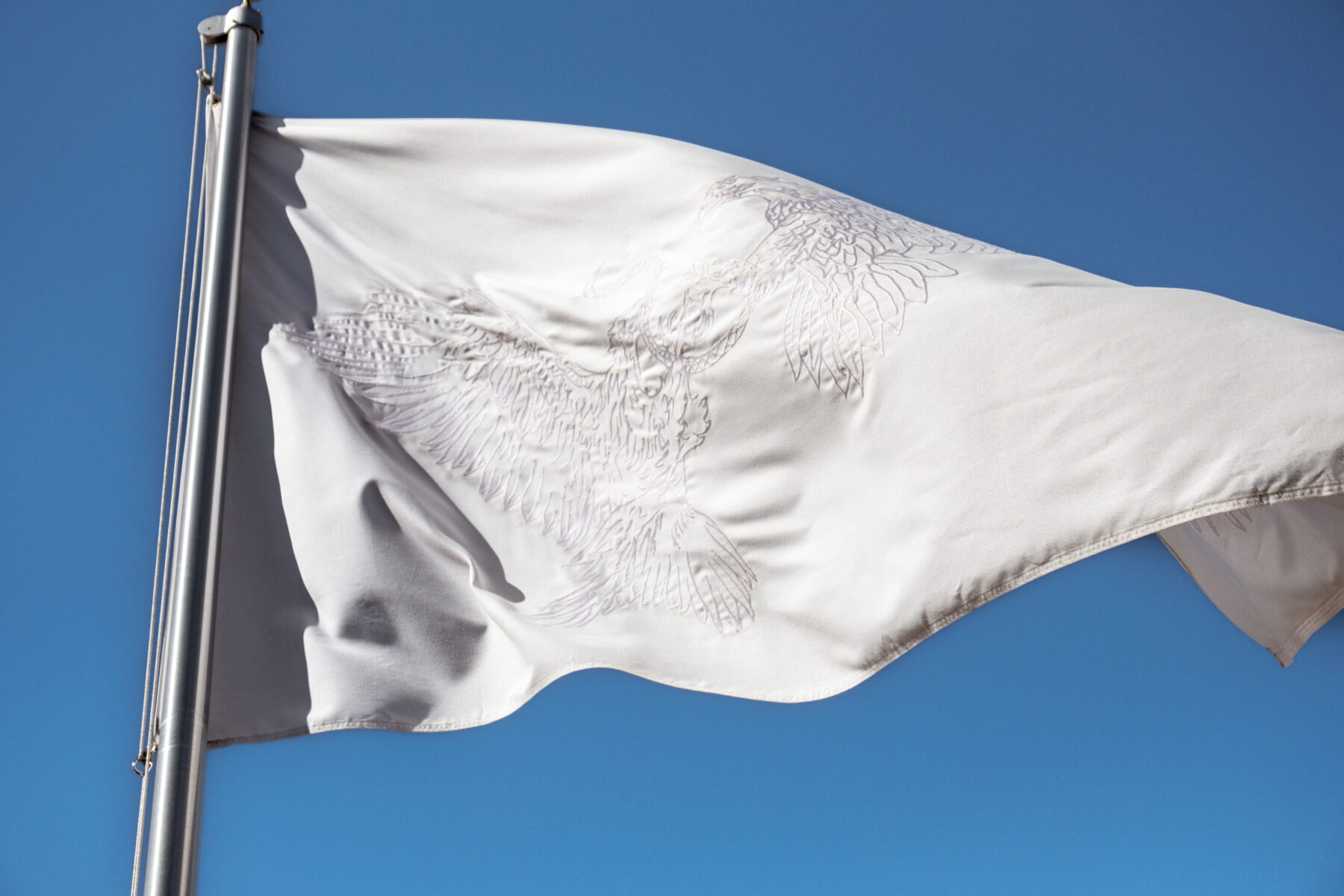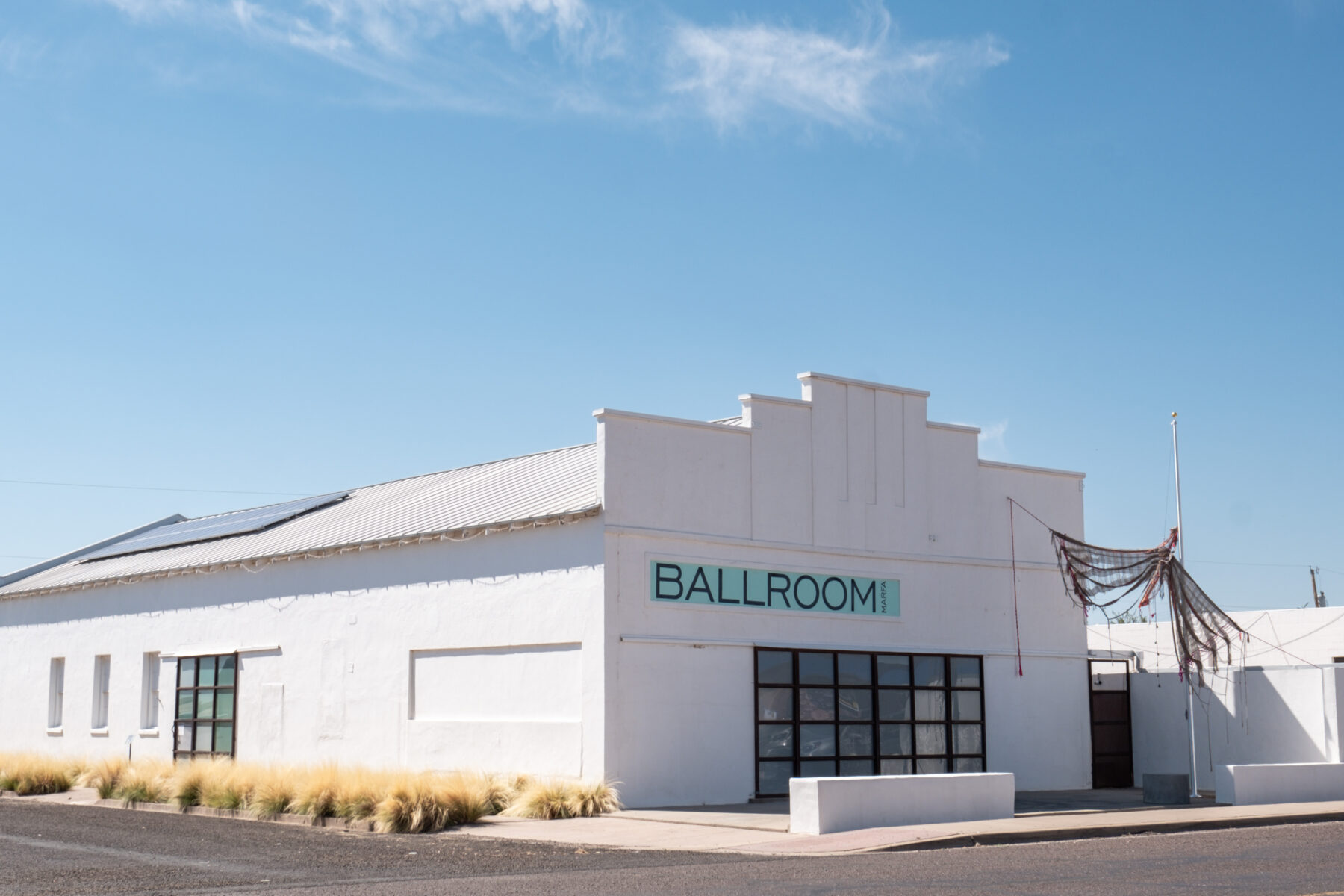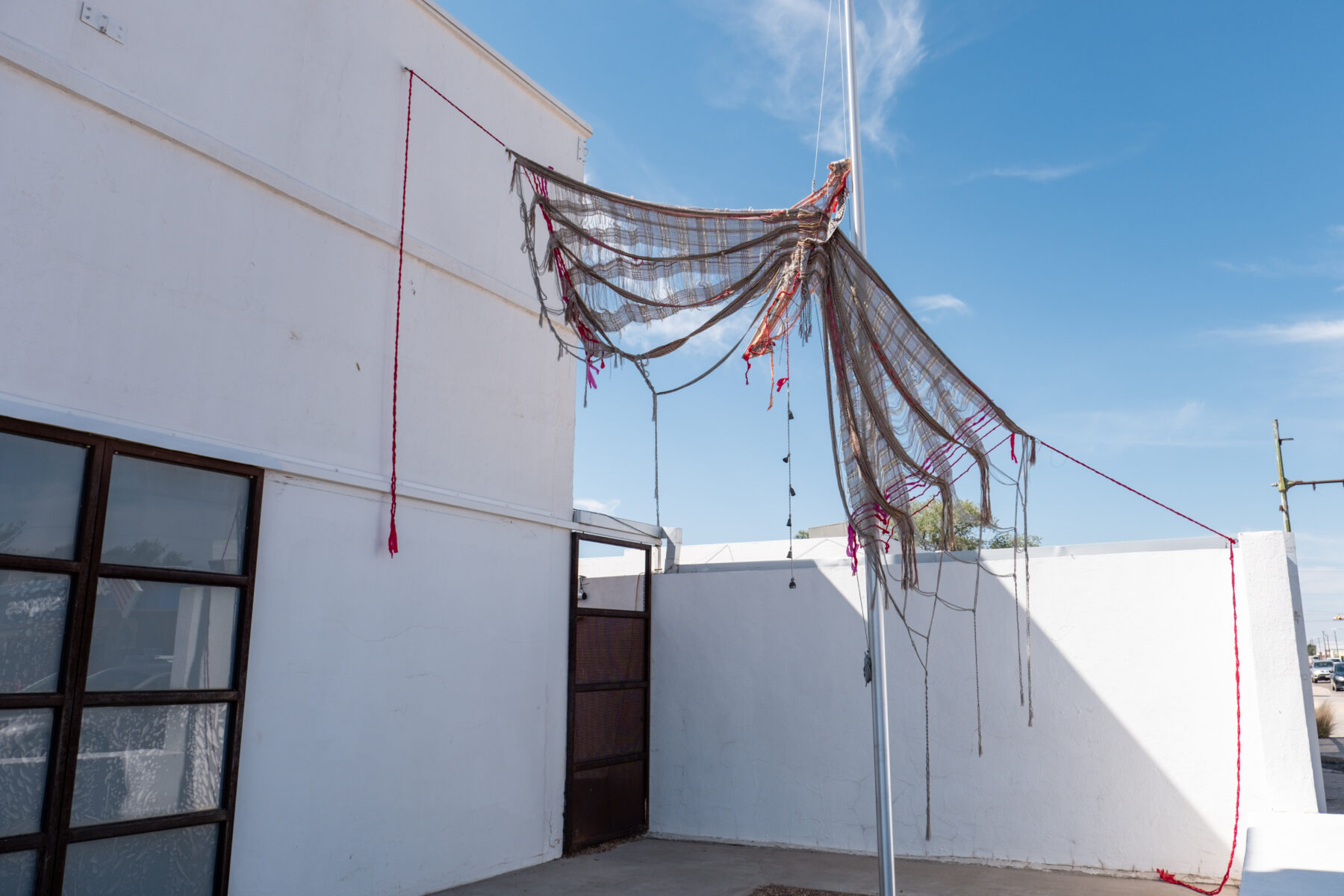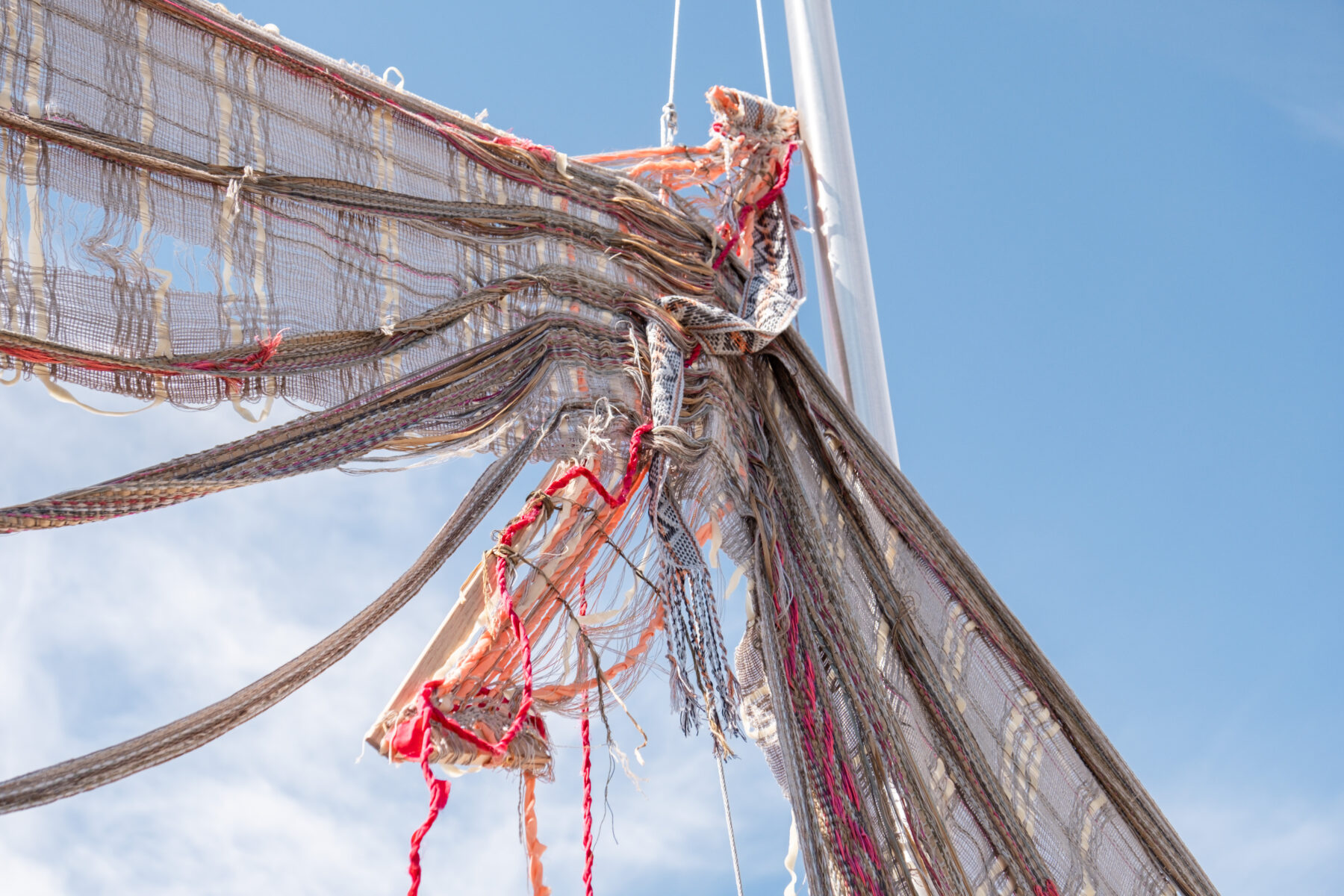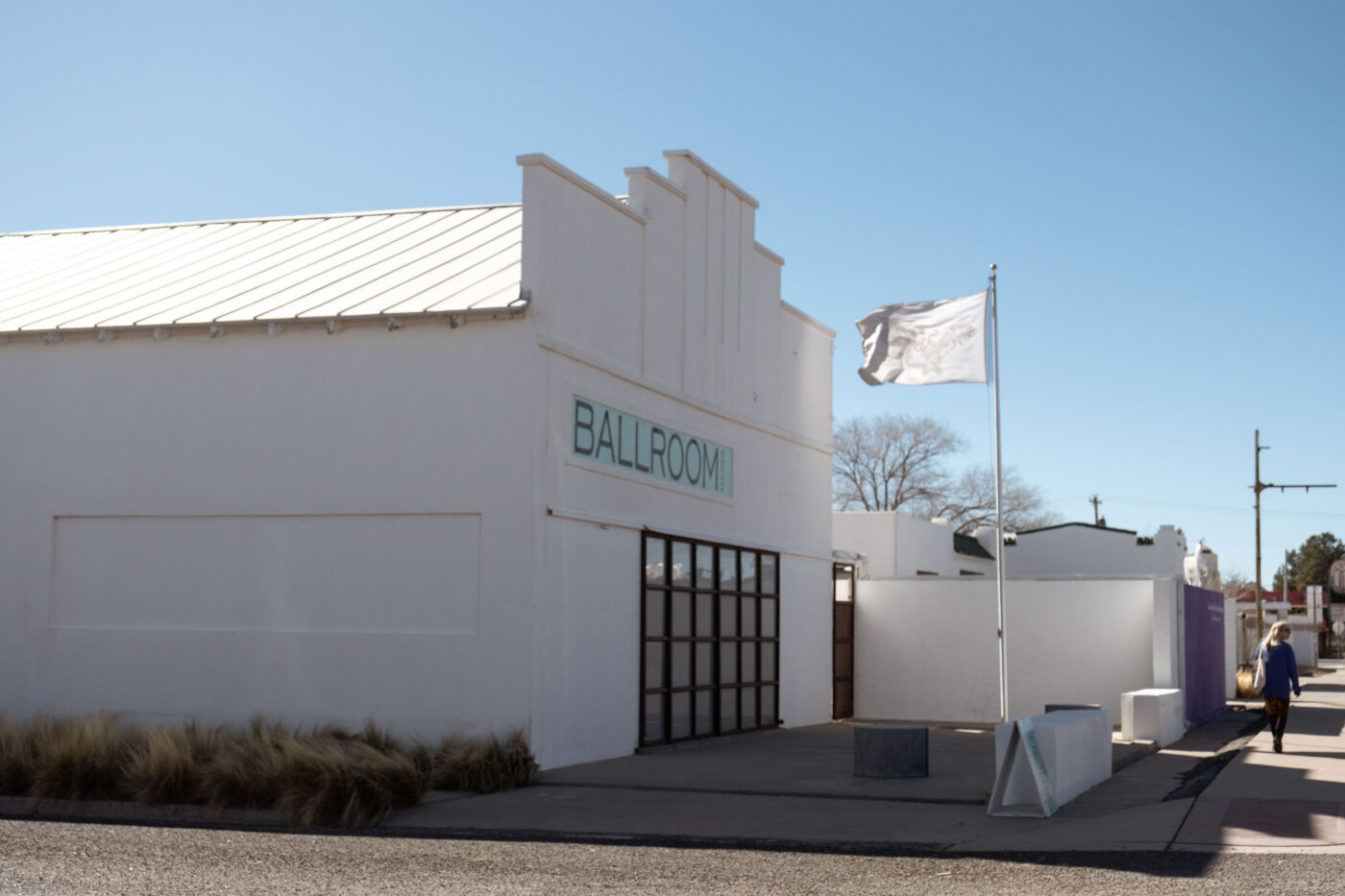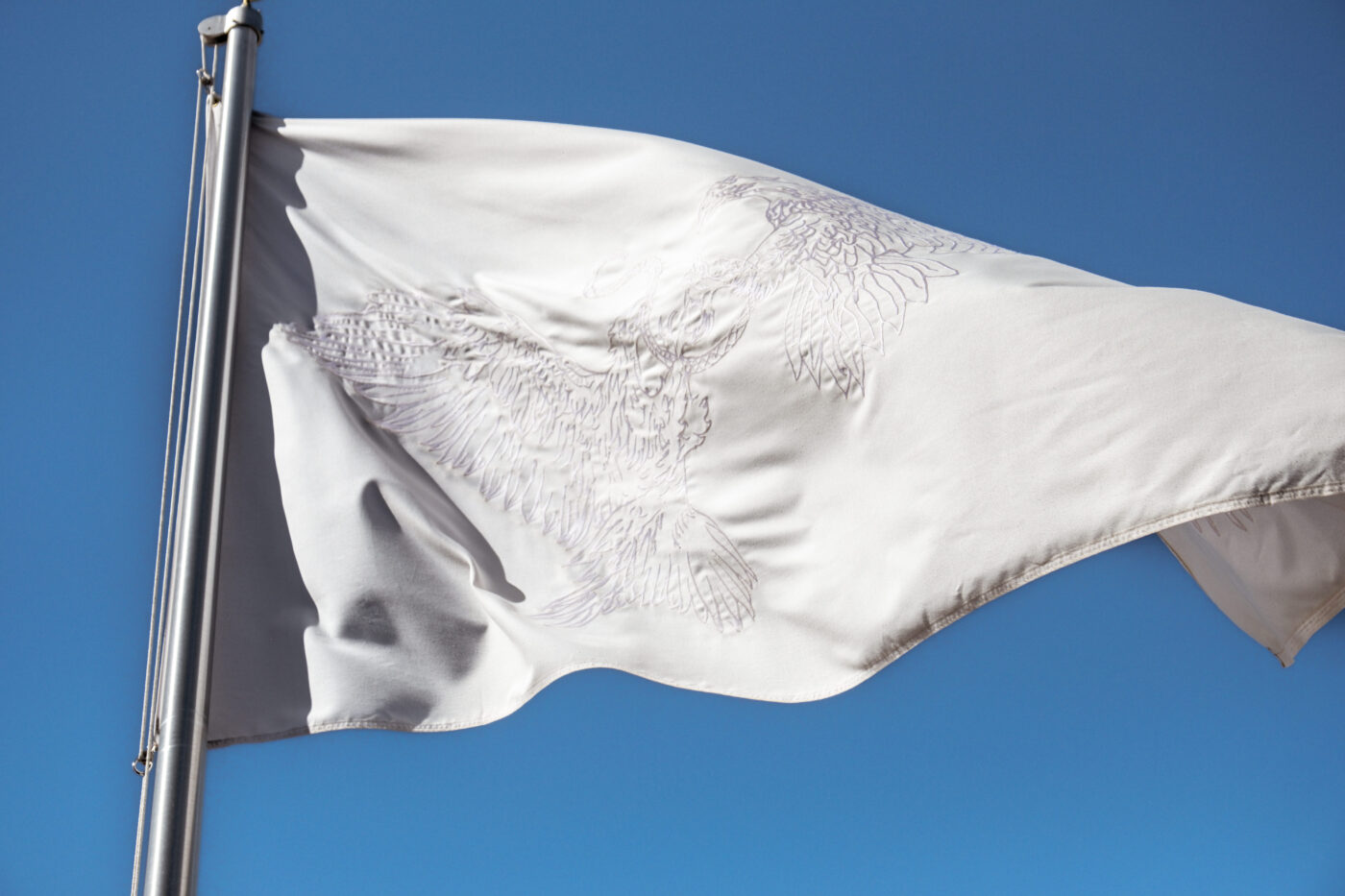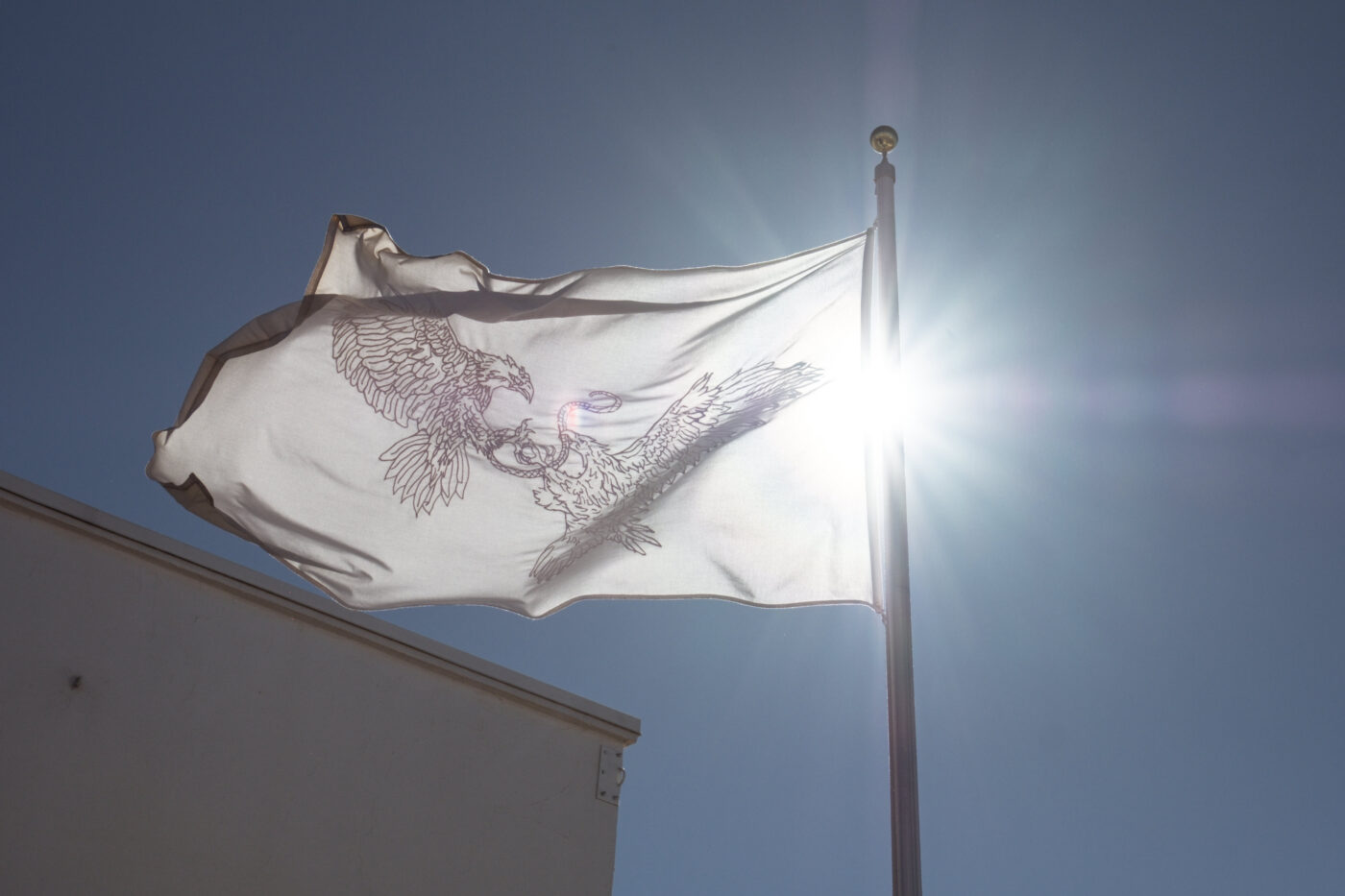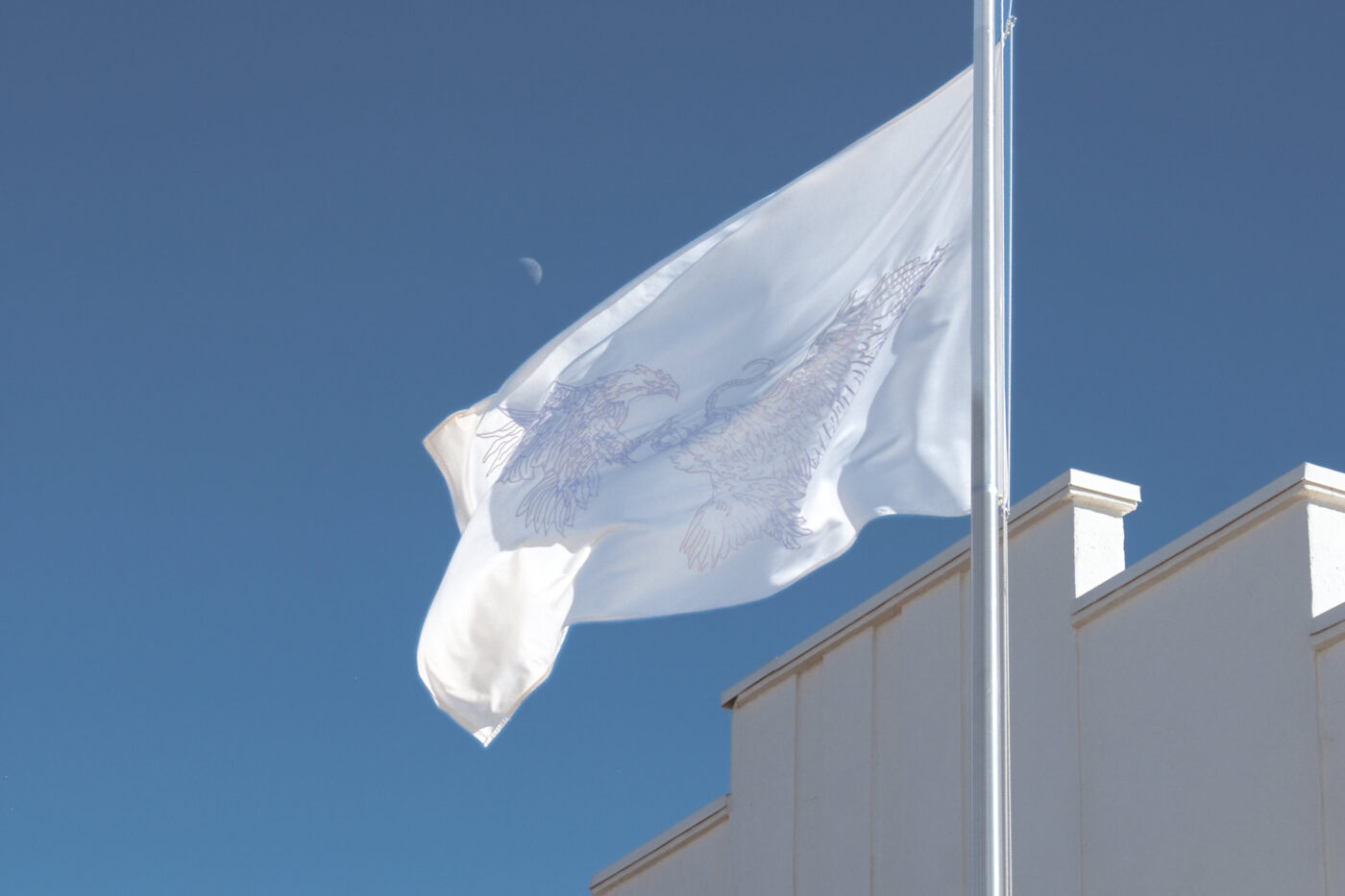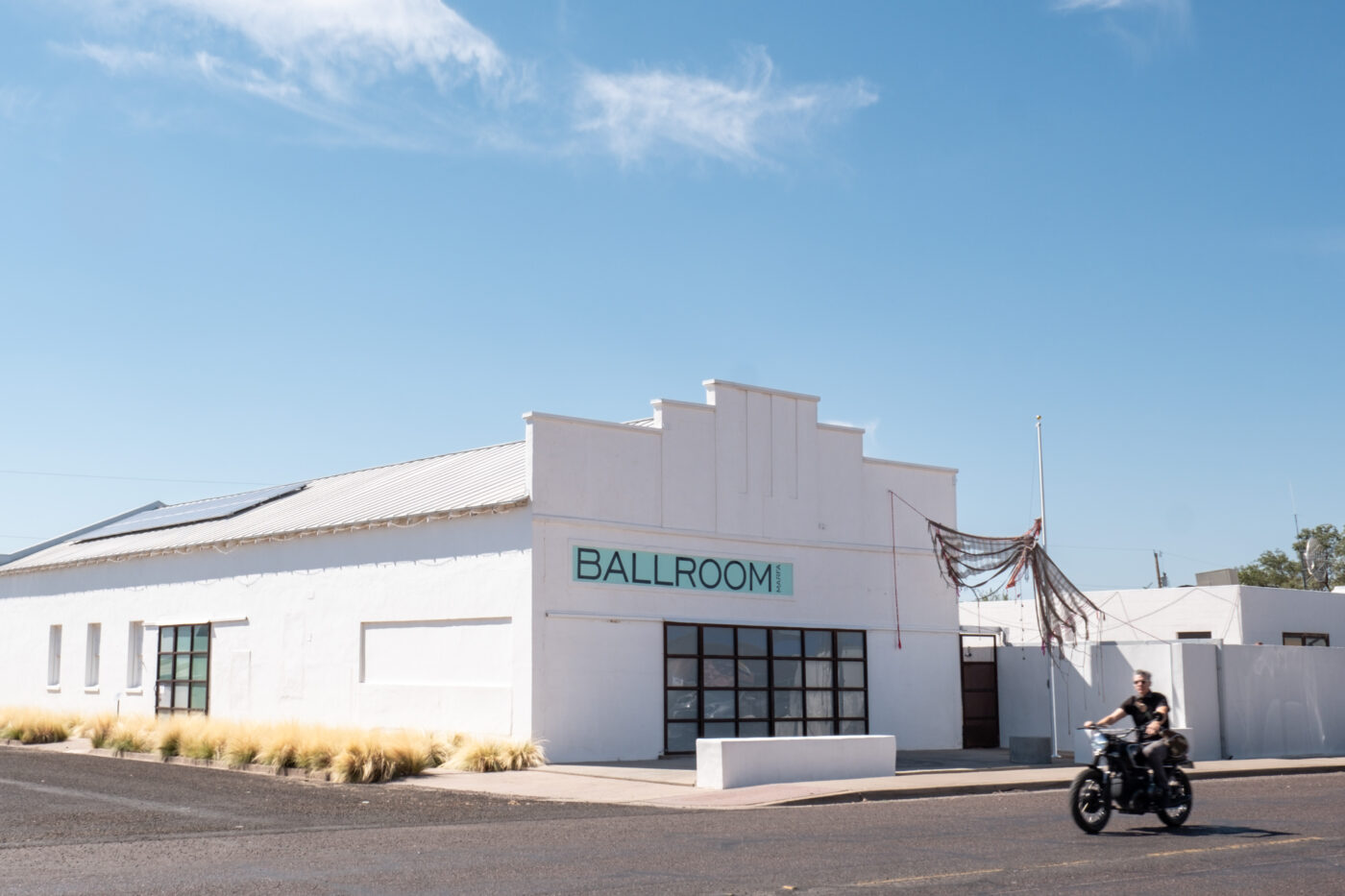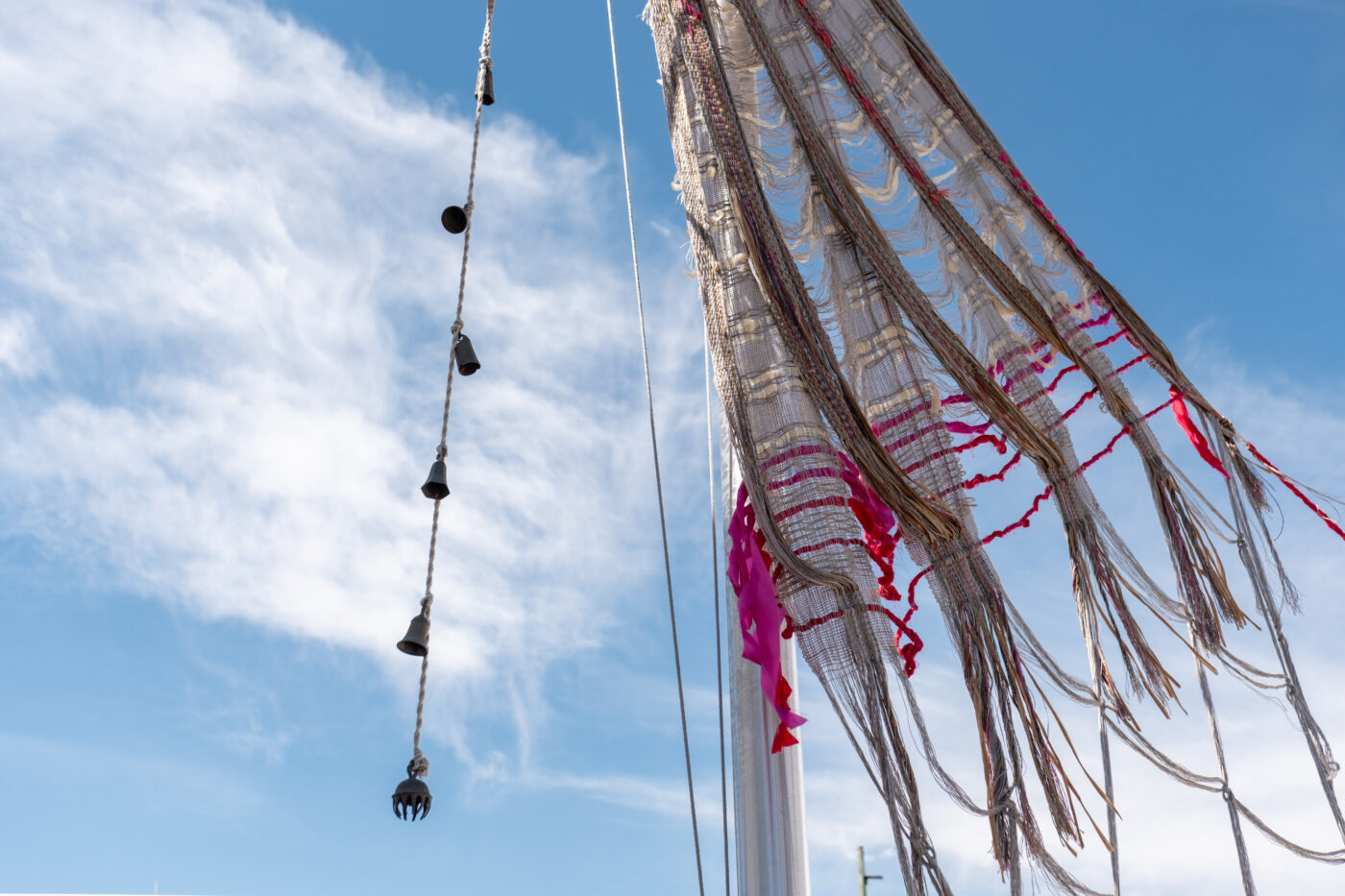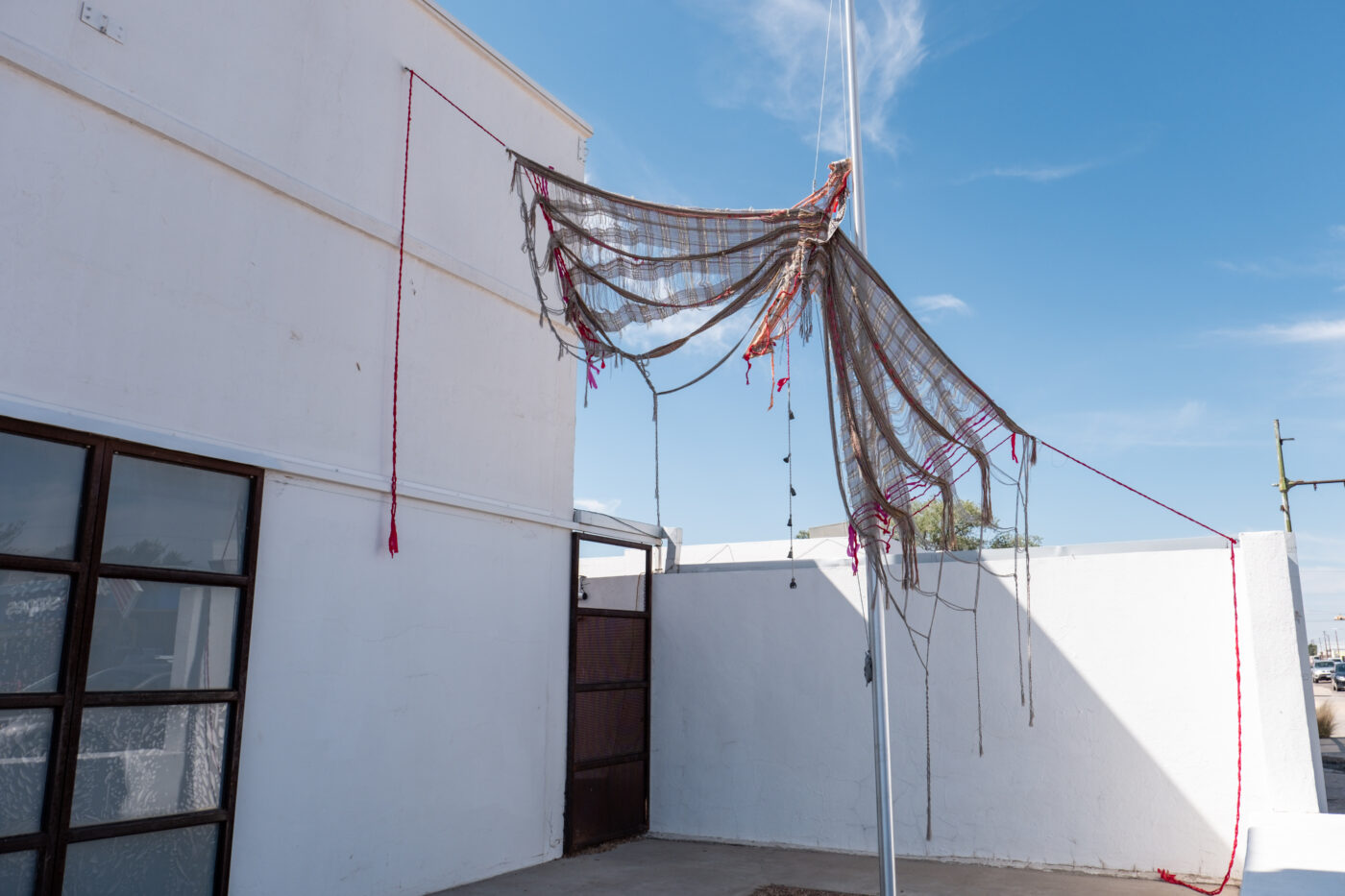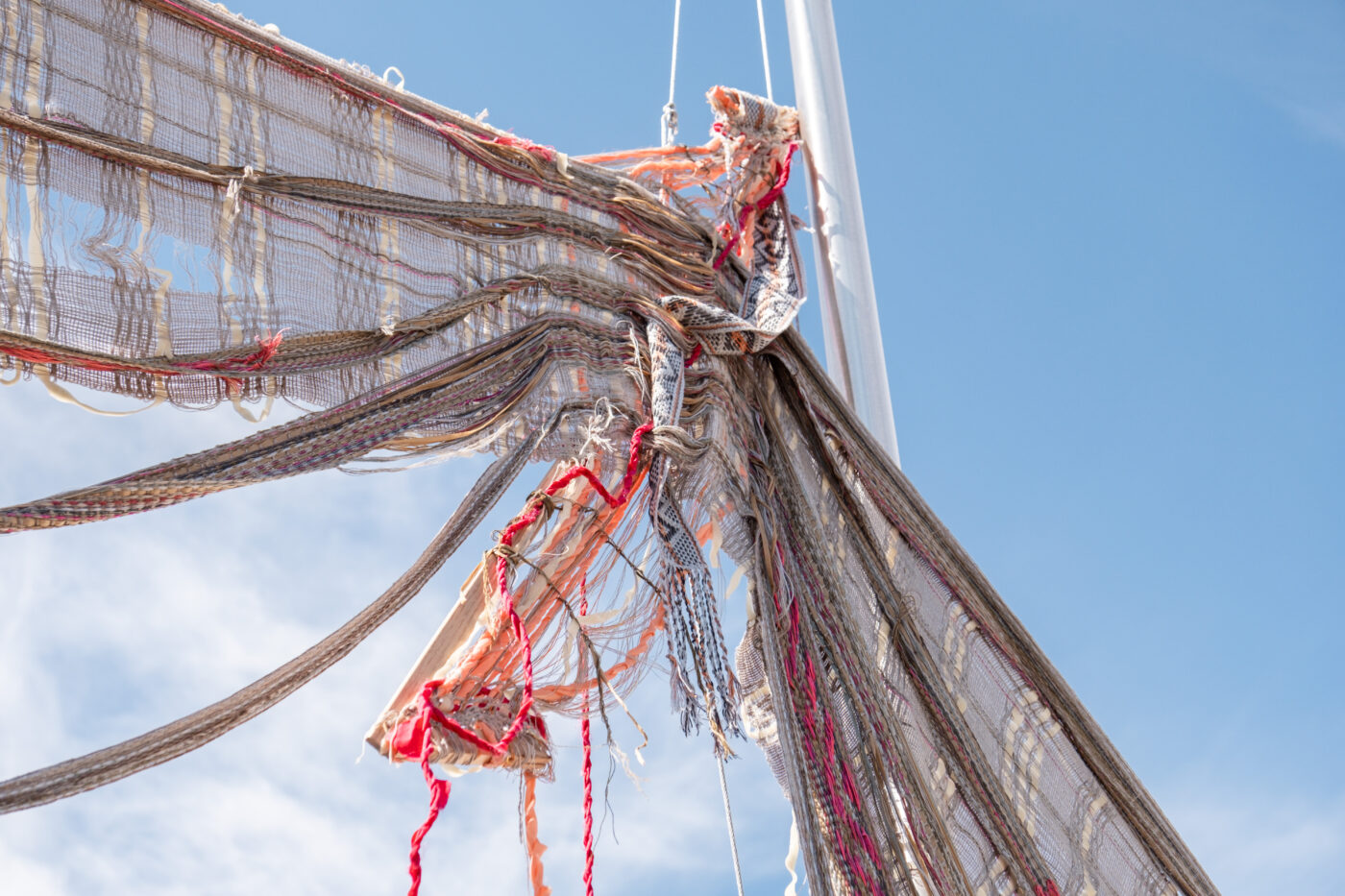
Exhibition
Kira Dominguez Hultgren, Adriana Corral, María de los Angeles Rodríguez Jiménez
September 25, 2023 – October 20, 2024
In the fall of 2023, Ballroom Marfa presents unFlagging: Futures. This year-long, outdoor exhibition opens September 25, 2023 and features a series of commissioned flags from multiple female artists displayed in Ballroom’s facade. Each artist examines the flag as a symbol of liberty, power, and identity through an eco-feminist lens. Their individual flags vary in material, method, and symbology, to articulate the contemporary moment in relation to the future. Flags are powerful political and cultural objects that serve as blueprints for imagining more equitable futures. unFlagging: Futures asks artists and audiences, what should the flags of the future look like?
Each artist’s flag will be on view individually, rotating through each artist in the series from September 2023 to October 2024. unFlagging: Futures includes work by Kira Dominguez Hultgren, Adriana Corral, and María de los Angeles Rodríguez Jiménez.
The artists in unFlagging: Futures revisit the rituals and symbologies of flags as seen in unFlagging, a 2020–2021 Ballroom exhibition organized by Daisy Nam, Executive Director & Curator, and Sarah Meléndez, Music Curator.
unFlagging: Futures is organized by Alexann Susholtz, Exhibitions Manager, Ballroom Marfa.
SCHEDULE OF FLAGS
September 25, 2023 – January 4, 2024: Kira Dominguez Hultgren
January 5 – June 9, 2024: Adriana Corral
June 12 – October 20, 2024: María de los Angeles Rodríguez Jiménez
Kira Dominguez Hultgren
Kira Dominguez Hultgren
With their flag, In the land of flying misssnakes, I stole Lupe’s string bikini, artist Kira Dominguez Hultgren reckons with environmental devastation and the impact of the fast fashion industry on the environment. Weaving natural and artificial materials together on the loom, Dominguez Hultgren’s piece mimics a bird about to take flight. With this work she asks, can we coexist peacefully, and respectfully with the natural world? The artist considers this flag “a collaboration with the Marfa desert, using materials that are not made to withstand or work against the desert, but remain open to however the desert wants to respond to this flag-staking.” Our future is in the hands of this present moment. Dominguez Hultgren reminds us of the need to coexist with all the elements.
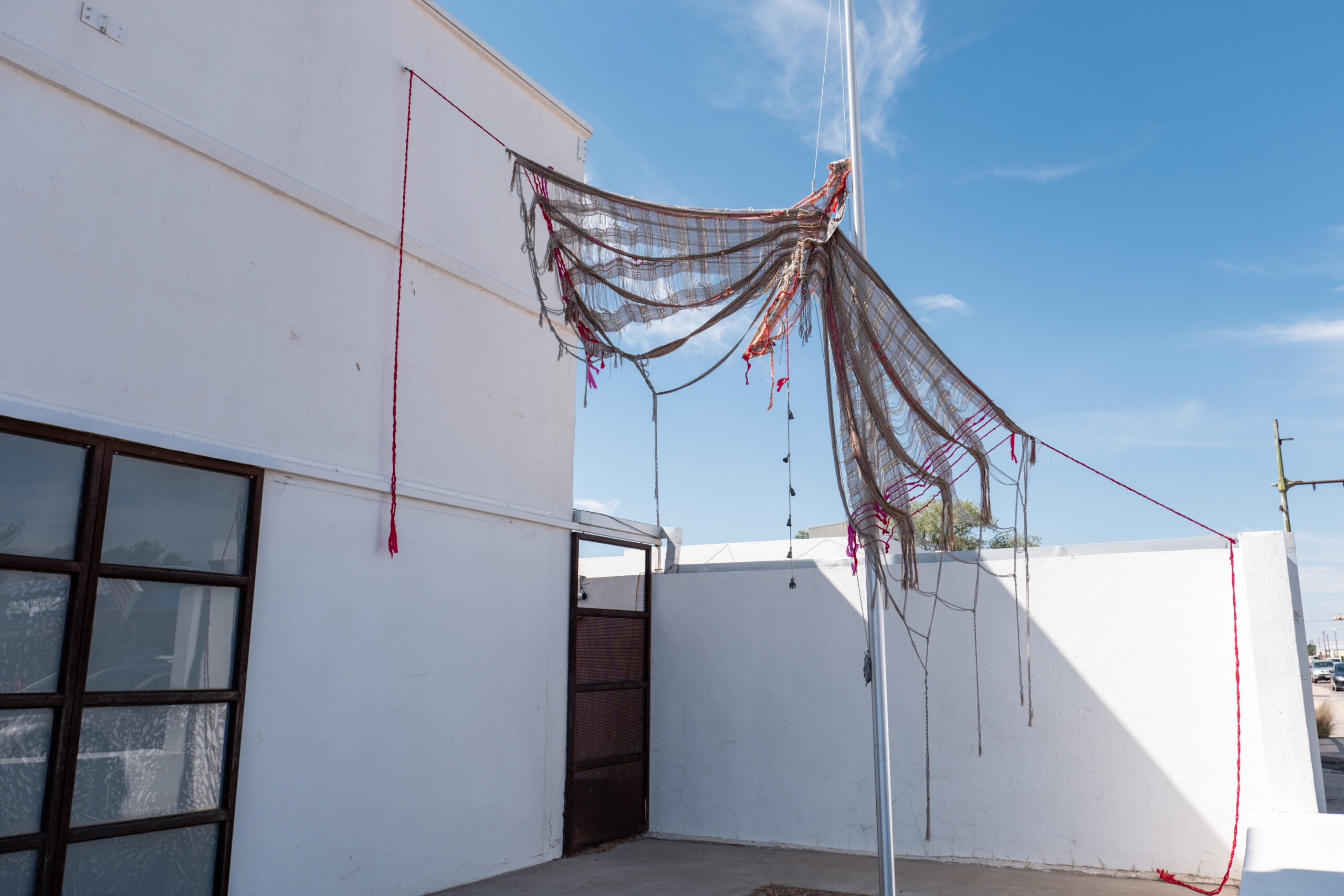
Kira Dominguez Hultgren, In the land of flying misssnakes, I stole Lupe’s string bikini, installation view, 2023. Linen, nylon, and bioplastics; stretcher bars, clips, and bells, 159 x 216 x 8 in. (dimensions variable). Photo by Sarah Vasquez.
ARTIST PROFILE
Kira Dominguez Hultgren (b. 1980) is a U.S.-based artist, weaver, and educator. She studied postcolonial theory and literature at Princeton University, and studio arts and visual and critical studies at California College of the Arts. Their research interests include material and embodied rhetorics, re-storying material culture, and weaving as a performative critique of the visual. Dominguez Hultgren weaves with the material afterlife of a so-called multiracial family: Chicanx-Indigenous-Indian-Hollywood Hawaiian-Brown-Black. Instead of being passed down, weaving and textile processes are brought up, and resurrected from family stories and fabrics. Dominguez Hultgren builds looms to weave into the frayed edges of lost language, culture, traditions, and lives that were deliberately cut-off in past generations. Her looms – whether digital jacquard, backstrap, floor, post–materialize this present absence often as largescale checkboxes and X-marks. Questions about cultural appropriation and codeswitching, exoticism, and performing cultural misrecognitions occupy their practice. Dominguez Hultgren has exhibited her work broadly including shows at the de Young Museum, Lehmann Maupin Gallery, the San Jose Museum of Quilt and Textile, and Eleanor Harwood Gallery. Their work has received critical attention including reviews in the New York Times and Architectural Digest. Dominguez Hultgren is an assistant professor at the University of Illinois Urbana-Champaign.
Adriana Corral
Adriana Corral
Ballroom presents Unearthed: Desenterrado, a flag by artist Adriana Corral as a part of the ongoing series, unFlagging: Futures. With this seemingly serene work, Corral deftly interrogates the political, social, and economic systems of the Bracero Program and more broadly, highlights American reliance on the Mexican labor force. The work retraces the lasting legacies of The Bracero Program on both the landscape and the communities that inhabit the West Texas region adjacent to the U.S. and Mexico border.
Corral interrogates this subject from a deeply personal lens. Corral’s own grandfather immigrated to the United States from Mexico as a guest worker through The Bracero Program. He settled in the Marfa area, as an agricultural worker. It is through this personal perspective, that Corral presents work that “addresses human rights violations and the ways that memories of them are threatened by erasure.” The work, Unearthed: Desenterrado, was originally displayed in Socorro, Texas, near Marfa, at the Rio Vista Processing Center. This center, now a nationally designated historic site, processed over 80,000 guest workers from Mexico who were subject to harmful “sanitation” control methods. At the processing center, the guest workers we subjected to harm through the “distinfecting” techniques, where pesticide chemicals like cyanide, kerosene, and Zyklon B were used as methods of control. This maltreatment inherent to The Bracero Program mirrors the current border crisis and the current treatment of immigrants seeking asylum at the hands of Operation Lonestar, the child separation act and other strategies and scare tactics enacted in the name of border control.
Originally commissioned by Black Cube in 2016, Unearthed: Desenterrado uses recognizable symbols of patriotic iconography to bring awareness to an oft-overlooked program in U.S. and Mexican history. The solemn white cotton flag features an “American” bald eagle and a “Mexican” golden eagle embroidered with fine white thread on either side. The aviary imagery recalls symbols of strength and patriotism respective to each country, inhabiting a shared space on the flag and the borderlands landscape.
Mounted at the facade of Ballroom Marfa, which is located on the main thoroughfare in and of the town, the double-sided flag both beckons and bids adieu to all those passing through Marfa. Corral’s research into the the Mexican national labor force in the United States is placed in historical and contemporary context with this work, asking her viewers to contemplate how the United States treats its migrant labor force, both now and then. Corral confronts this difficult history to prompt change in the future.
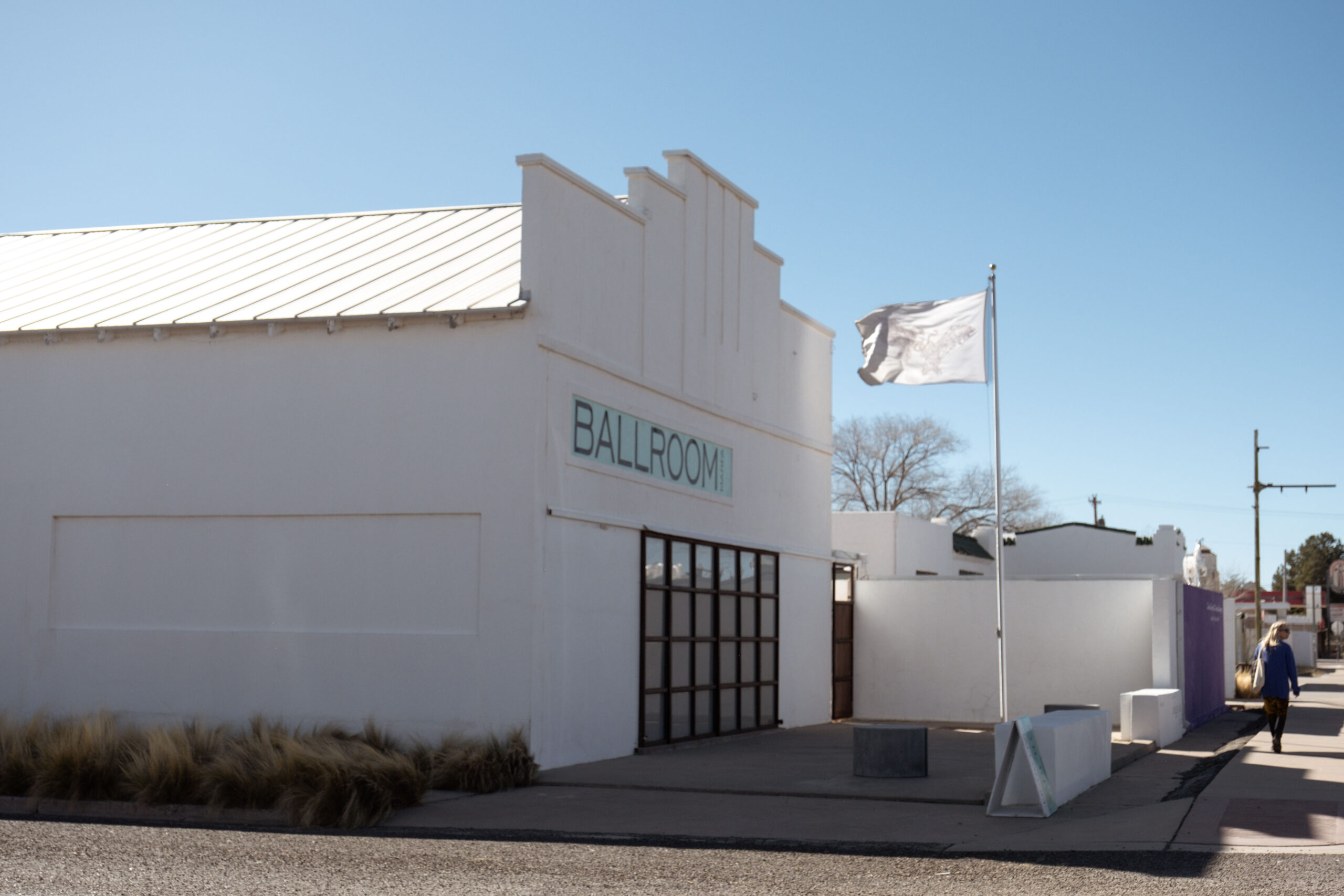
Adriana Corral, Unearthed: Desenterrado, 2018-2024. 25 ft. stainless steel flagpole, 6 x 8 ft. embroidered golden and bald eagle on white cotton flag. Courtesy the artist and Black Cube. Photo by Sarah Vasquez.
Artist Profile
Adriana Corral (b. 1983) received her MFA from the University of Texas at Austin and completed her BFA at the University of Texas at El Paso. Corral was awarded a Harpo Foundation Award (2020), an Artadia Award (2019), she was invited to attend the 106th session of the Working Group on Enforced and Involuntary Disappearances at the United Nations in Geneva, Switzerland (2015) and was selected for the Joan Mitchell Foundation Emerging Artist Grant (2016). Corral attended the McDowell Residency (2014), Künstlerhaus Bethanien Residency in Berlin, Germany (2016), the International Artist-in-Residence at Artpace (2016), was a fellow at Black Cube, a Nomadic Art Museum (2017), an artist research fellow at the Archives of American Art and History at the Smithsonian Institution (2018), an Artist-in-Residence at the Joan Mitchell Center (2018) and will be participating in Prospect 5 New Orleans: Yesterday we said Tomorrow (2021).
Whether facing the internal breakdown of the body or the environment in which it exists, Corral’s work seeks to understand the dynamics of a social structure where power, corruption, and class bias dominate. Corral’s subjects are informed by human rights abuses, memory, and erased historical narratives. The work harkens back from her experiences growing up in her birthplace, El Paso, Texas, a city that borders Juárez, Chihuahua, Mexico. It is through the lens of these experiences that the artist examines local, national, and international consequences of immigration, citizenship, economic trade, labor, public health, safety, security, and policy. Deeply rooted in historical research, Corral’s rigorous interdisciplinary practice often leads her to work in the archives. In the past, experts ranging from historians, librarians, anthropologists, writers, journalists, architects, human rights attorneys, and the victims’ families have provided her with vital data that aid in the conception of Corral’s works. She knows firsthand the impact a project can have when it has the support and expertise of others. Corral believes art can play an important role in building awareness and empathy. Corral’s current work seeks to amplify the voices and perspectives of those most marginalized.
María de los Angeles Rodríguez Jiménez
María de los Angeles Rodríguez Jiménez
Shimmering against the Marfa skies, Ballroom Marfa presents Apaxoro by María de los Angeles Rodríguez Jiménez in UnFlagging: Futures.
Jiménez, a Cuban-born, New York-based textile artist creates an idealized Cuban flag for Ballroom Marfa. The work speaks to the artist’s own displacement from her country of origin and articulates a newly imagined Cuban identity.
With tenderness and care, Apaxoro questions notions of belonging and unravels the artist’s memories of her Cuban home. Her flag evokes a spirit of hopefulness that is mirrored in the vastness of the West Texas landscape.
Her flag evades simple categorization in its integration of spirituality and presence, reminding the audience to be here now. The soft fabric moves with the wind; it glistens in the light and playfully beckons for our attention. The flag performs for its viewer, activated by unseen forces reminding us that home exists as both a mental and physical place.
Artist Profile
María de los Angeles Rodríguez Jiménez (b. 1992) is an interdisciplinary artist from Holguín, Cuba. She received her BFA from The Cooper Union for the Advancement of Science and Art in 2015 and MFA in Painting and Printmaking from Yale University in 2020. Rodríguez Jiménez has participated in residencies such as the Skowhegan School for Painting and Sculpture (2016), SOMA Summer (2019) and Pivô Arte e Pesquisa (2023). Her work has been exhibited in institutions such as the High Museum of Art (Atlanta, GA), the Frost Art Museum (Miami, FL), and The Alabama Contemporary Art Center (Mobile, AL), among others. She was a recipient of The Fulbright Research Fellowship (2021) and the NYPL Jerome Robbins Dance Fellowship (2022), where she collaborated with Candomblé dancers and practitioners in Brazil. She currently lives and works in Brooklyn, New York.
Installation Views
Artist Talk: Adriana Corral in conversation with Daisy Nam
Acknowledgements
This exhibition is generously supported by Kathleen Irvin Loughlin; Fairfax Dorn & Mark Glimcher; Virginia Lebermann & Family; Lebermann Foundation; Ballroom Marfa Board of Trustees and the International Surf Club.
Ballroom exhibitions and programs are supported by Ballroom Marfa Board of Trustees: Abdullah Al-Turki, Charles Attal, Suzanne Deal Booth, Deborah Green, Matthew Day Jackson, Rashid Johnson, Molly Kemp, Vance Knowles, Liana Krupp, Jenny Laird, Maria Giulia Prezioso Maramotti, Nancy Sanders, Allison Sarofim, Anne-Cecilie Engell Speyer, Gordon VeneKlasen, and Leo Villareal; and the International Surf Club Founders: Rachel & Jeff Arnold; Louisa Stude Sarofim; Sara Carter; Eleanor Acquavella Dejoux; Christopher Hill & Lachlan Miles; and Alex Logsdail.
Special thanks to the artists and lenders: Moody Gallery; Betty Moody; and Lee Steffy. Many thanks to the installation and fabrication teams, Francisco Rosas; Xavier Gilmore; Anthony Rundblade; and Ballroom Marfa staff.
